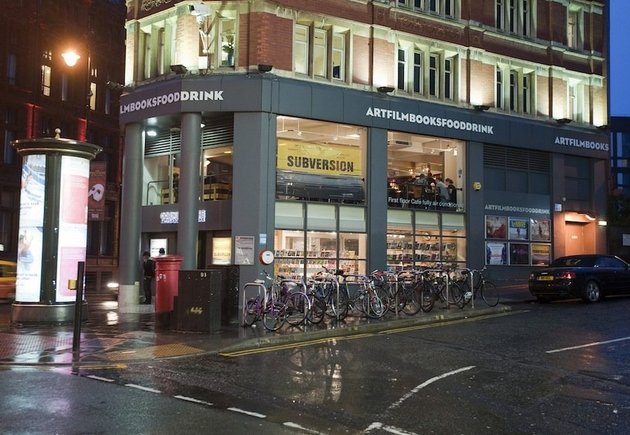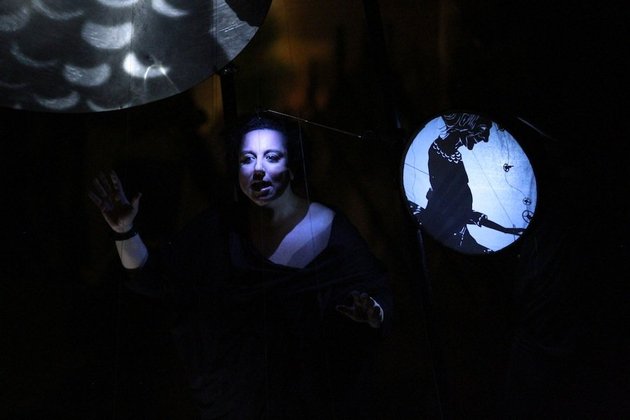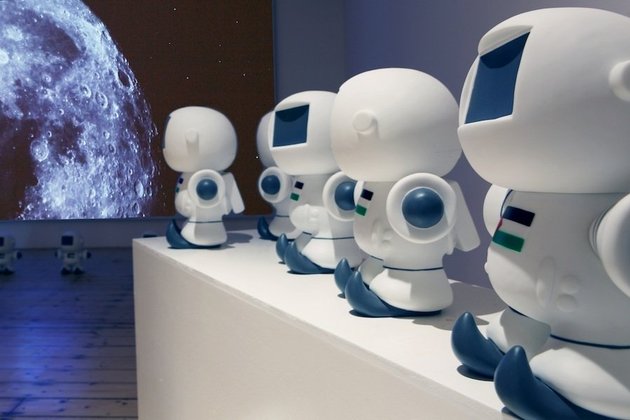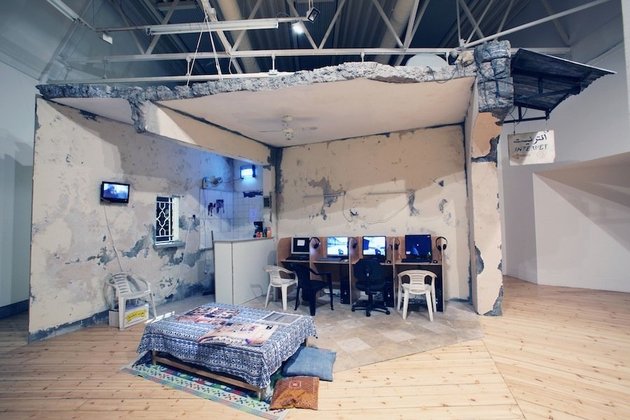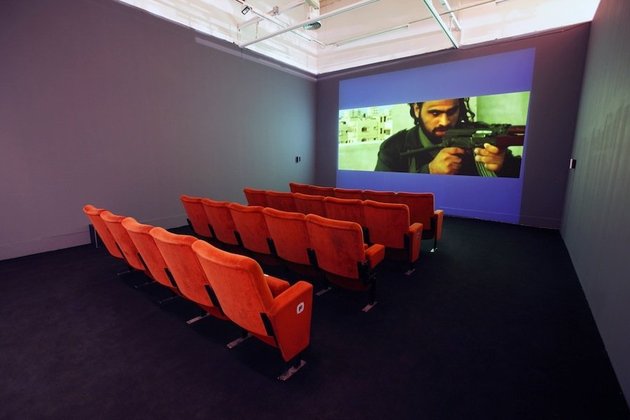News
The New Arab
Art and Culture in the ‘Imagined’ Arab World, Cornerhouse, Manchester, 13 April 2012
This symposium, The New Arab: Art and Culture in the 'Imagined' Arab World, accompanied the show Subversion at Manchester's Cornerhouse Gallery and was chaired by its curator Omar Kholeif. Opening the discussion with an introduction into the initial thoughts and ideas behind the exhibition, Kholeif cited a 'catalytic conversation' between artists, curators and writers working in and on the Middle East about the reconstruction and re-conception of Arab identity.
The first speaker was writer and SOAS teaching fellow Dr. Hanan Toukan, whose premise was to discuss the 'notion of subversion as critique versus subversion as rhetoric' in the discussion of contemporary arts. She examined the notion that Arab artists are often called upon to explain their 'situation' (revolutions, post-colonial identity, gender and sexual repression, war, to name a few rather tired reference points), so as to make political events comprehensible to western audiences. Illustrating her point with political cartoons by illustrator Nidal Al Khaimy and citing a UN Human Development Report from 2002, Toukan identified the introduction of external non-governmental cultural and artistic aid to authoritarian Arab states. International institutions such as the Ford and George Soros Foundations have invested heavily in supporting cultural initiatives in the Middle East, filling the vacuum left by the de facto refusal of governments to do so, and when they do, do so ineffectively. Expanding critical art scenes in Cairo, Amman and Ramallah exist in opposition to the state which, Toukan suggested, forces cultural production into liminal spaces and creates, in turn, a 'subversive counter culture'. Toukan highlighted the serious ramifications of such funding, including the homogenising of art from the Middle East and reducing Arab artists to 'mere chroniclers of war'.
Moving on to examine the role of the arts in a 'post-Arab Spring' context, Toukan discussed the art world's response to political events in the Middle East, concluding that the objectives of funders focussed more fervently on the capacity for building independent art spaces, art and social change research and the use of art as a way of consolidating the revolution and transmitting the 'new face of the Arab world' to the rest of the world. However, an important complexity was highlighted here, as many funding bodies have disassociated revolutionary events in the Middle East from activism in their own countries. The British Council, for example, vehemently supports post-revolutionary cultural production in Egypt but its political umbrella, the Home Office, condemns the Occupy Movement in the City of London. In quoting Lebanese artist Ziad Abillama, Toukan brought home the point that such funding can be a form of forced democratisation as 'imperialism is not just about demeaning people. It is about talking to them, teaching them and restructuring them'.
Malu Halassa spoke next on the question of 'The New Arab', a term that has ignited debate, controversy and even issues of copyright infringement. She identified the founders of publishing house Dar Onboz, who seek to reinvigorate interest in the Arabic language through their whimsical children's publications. Working at a time when Arabic has been subsumed by French and English and considered too hard to learn by Arab youth, Nadine Touma and Sivine Ariss aim to make the language more accessible. Halassa also noted that the politics of identity of the Arab world is often played out in children's literature.
Moving on to Syria, Halassa drew the audience's attention to the new art forms being developed by young activists in the revolution, referencing mobile cinema bringing footage of the revolution to the world and decoy sound installations in trees and on roofs to trick government forces in major Syrian cities. Screening an episode of the popular political puppet show 'Massasit Mati', Halassa demonstrated how humour is embodied as an art form of its own in circumstances of strife. Omar Joseph Nasser-Khoury, a Palestinian fashion designer, was mentioned as an example of young artistic players re-forming their cultural identity and creating a new alchemy of heritage and the contemporary.
Omar Khloeif presented a conversation between Noreen Abu Oun, Executive Director of the Arab British Centre (ABC) and Amal Khalaf, assistant curator at The Centre for Possible Studies, a Serpentine Gallery initiative part of The Edgware Road Project. The participants discussed the roles their respective institutions play in cultural production and exchange in the UK, both concluding that they work to present Arab culture 'not just in the best light, but most honestly'. Members of the audience engaged in the conversation, some expressing unease at the notion that Edgware Road and ABC's historical colonial ties speak to an already established western trajectory of Arab identity.
To end the symposium, artist and founder of 98 Weeks Research/Project Space in Beirut, Marwa Arsanios and Eyad Houssami, a playwright, actor and director based in Lebanon, performed a role play touching on the nature of Arab and Mancunian identities.
Following the symposium, a tour led by curator Omar Kholeif shed light on his desire to create a three-fold experience comprising outer space, contemplative space, and interactive space with new media and video. Eleven artists from across the region explored Arab identity with humour, reacting to preconceived notions of what it means to be an Arab artist working today in post-colonial, post-war and in some cases, post-revolutionary environments.
Larissa Sansour exhibited her Palistinauts (2010) and Space Exodus (2009) video and photo series (watch out for her upcoming project on Ibraaz). Images from her recent Nation Estate project – expunged from the Lacoste Elysée Prize due to external pressures – imagines a Palestinian state as a skyscraper, alluding to methods of nation-building currently employed by the Palestinian Authority. Khaled Hafez's humorous video The A77A Project: On Presidents & Superheroes constructs an Egyptian identity in a specific period in the past, as disco music collides with Nasser's speech. In what Hafez calls an 'autocritique of the situation of the Egyptian street', we watch the figure of Anubis, an Ancient Egyptian superhero-type figure fuse with the common man to create a masked vigilante, walking the streets of Cairo. Two videos by Akram Zaatari re-examine the identity of the homosexual man in Lebanon, whilst Sharif Waked subverts the typical visuals of suicide bomber videos in his video To be continued ... (2009) as the would-be martyr defers violence through his never-ending monologue rather than inciting it.
The top floor, dubbed by Kholeif as the 'playground,' evoked the atmosphere of a film set. Wafaa Bilal replicates an internet café that could be found Baghdad or Old Damascus; visitors were encouraged to interact with the piece by playing on computer games or reading publications selected by 98 Weeks, Beirut. Peer out of the window and you catch glimpses of graphic film posters by award-winning twin artists Tarzan and Arab. Their film Colourful Journey can be watched in the comfort of a pop-up cinema which made for a relaxing end to a rewarding day.

